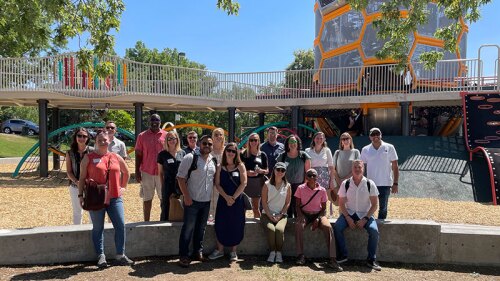While it is generally known that good schools enhance property values, it is not always clear how to improve an existing school system in a way that would benefit a community. Speakers at the 2016 ULI Fall Meeting described their approaches to adding value with stronger schools in both distressed urban neighborhoods and affluent greenfield developments.
Moderator Jess Zimbabwe of ULI’s Rose Center for Public Leadership in Land Use said that in two-parent families of school-age children, good schools are often the driving factor for home selection. Doug Quimby, president of Colorado-based La Plata Communities, agreed, which is why he works closely with local school districts to make schools the centerpieces of his master-planned communities.
“High-performing schools are the number-one reason why 80 percent of our buyers choose our communities,” he said. His company often goes beyond the legal requirements for either paying impact fees or dedicating land to the local school district, as well as the underlying infrastructure.
La Plata’s Briargate development in Colorado Springs, now in its final stages, has four high schools, three middle schools, and eight elementary schools. The developer has catalyzed school development in a number of ways, including dedicating more than the required acreage, waiving the infrastructure cost reimbursement, siting the schools optimally within their communities, developing trails that allow students to walk or bike to their schools, landscaping school property, and negotiating agreements that allow community residents to use school facilities when classes are not in session. In one case, funds freed up by La Plata’s donated infrastructure allowed accelerated delivery of a new school. “This was one of the best decisions we have ever made,” said Quimby. “The new school was a big draw.”
Strong public schools can provide direct benefits to developers. “If you compare our homes at Briargate with similar homes in lower-performing districts, we get a 50 percent premium, or about $30,000 per lot,” noted Quimby. “Each new home sells for about $50,000 above the area median price of $250,000.” In another of La Plata’s communities, with lower price points, the premiums are not as high, but the homes sell faster than La Plata can deliver them.
While it is easy to see the value of high-performing schools in greenfield developments, distressed urban neighborhoods with failing schools face almost insurmountable challenges. But some people like a challenge, and one of those people was retired top tennis player and Olympic gold medalist Andre Agassi. He and Bobby Turner launched the Turner-Agassi Charter Schools Facilities Fund to address social inequities through infrastructure solutions. “There is a proven correlation between optimal school facilities and academic success,” Aarthi Sowrirajan, a regional director with the fund, told the ULI Fall Meeting session audience.
Sowrirajan explained that after raising $210 million from institutional investors, the fund has built 65 charter schools, providing 35,000 school seats. The fund is close to raising another $350 million in equity to fund construction of 100 to 120 schools, which will yield another 70,000 school seats. Many of their projects are in Las Vegas, Nevada, where overpopulated Clark County has not built new public schools for many years. Turner-Agassi’s new school buildings are sold to their operators three to five years after delivery, at predetermined prices, generating unlevered returns of 8.5 to 10 percent for the fund’s investors.
Based on its success, the fund is expanding into acquiring multifamily properties in the vicinity of their schools. “By understanding what communities need, we can generate profits by decreasing vacancies, not by raising rents,” Sowrirajan went on. “We also build communities by providing subsidized housing to teachers and tutoring for students.” To further its holistic approach to community-building, the organization plans to invest in health care facilities.
Another pioneer in turning around distressed neighborhoods is Purpose Built Communities, a nonprofit consulting firm founded by Tom Cousins of Cousins Properties, who was later joined by billionaire investor Warren Buffett and former hedge fund manager Julian Robertson. “To make these neighborhoods healthy again after decades of neglect, we need a high-quality educational pipeline from cradle to college,” explained David Edwards, chief executive officer of Purpose Built Communities. “We can’t get a school to outperform its neighborhood, so we need in the neighborhood revitalization business.”
The Purpose Built Communities Model was pioneered in the mid-1990s after the successful transformation of the East Lake neighborhood in Atlanta. Following this effort, the neighborhood school leapt from 69th to third best in the city; home values soared from about $40,000 to $260,000; and the area attracted some $400 million in private investment.
By applying its holistic model to other areas of concentrated urban poverty around the nation, Purpose Built Communities is helping local leaders make a positive impact in some of the nation’s most distressed neighborhoods. Purpose Built now has 16 projects operating around the United States, with another 30 in pipeline.



